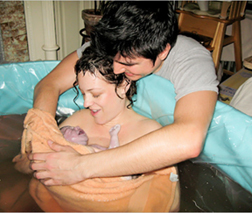Most women who have had Caesarean sections can safely give birth the normal way later, studies have shown, but in recent years hospitals, doctors and insurers have been refusing to let them even try, insisting on repeat Caesareans instead.
The decisions have been based largely on fears of medical risks and lawsuits, medical and legal experts say.
The hospital rules have infuriated many women, added to the nation’s ever-increasing Caesarean rate and set off a bitter debate over who controls childbirth. Now, the American College of Obstetricians and Gynecologists is issuing a new set of medical guidelines meant to make it easier for women to find doctors and hospitals that will allow vaginal birth after Caesarean, or VBAC (pronounced vee-back).
Women’s health advocates praised the new guidelines because they expand the pool of women considered eligible for vaginal births, but they expressed doubts about whether the recommendations go far enough to change a decade of entrenched behavior by doctors, hospitals and insurers.
The new guidelines replace the obstetrician group’s earlier ones — which were exactly what led many hospitals to ban VBAC in the first place. But the group says it never intended to limit women’s access to vaginal birth, and it acknowledges that its policies may have helped fuel the trend toward too many Caesareans.
“It will be better for women in the long run if we can lower the C-section rate,” said Dr. Richard N. Waldman, president of the obstetricians’ group and chairman of obstetrics at St Joseph’s Hospital in Syracuse. The guidelines are being published on Thursday in the August issue of Obstetrics & Gynecology.
About 1.4 million women had Caesareans — or about 32 percent of all births — in 2007, the latest year with figures available, according to the National Center for Health Statistics. Like earlier guidelines, the new ones say that vaginal birth is safe for most women who have had a Caesarean, provided that the cut in the uterus was low and horizontal, the way nearly all Caesareans are performed today. Sixty to 80 percent of women who have what doctors call “a trial of labor” — an attempt to deliver vaginally — after a Caesarean succeed.
The new guidelines go beyond the earlier ones, however, stating that vaginal birth after Caesarean is also reasonable for most women carrying twins and those who had two prior Caesareans.
Even if a hospital does not offer trials of labor after Caesarean, the group says, “such a policy cannot be used to force women to have cesarean delivery or to deny care to women in labor who decline to have a repeat cesarean delivery.”
The main worry is the risk of uterine rupture during labor, which can severely harm both the mother and the child and requires emergency surgery. But the guidelines state that for women with one previous Caesarean, the risk of rupture during a trial of labor is quite low — from 0.7 percent to 0.9 percent. If the same woman has a repeat Caesarean instead, before labor starts, the risk of rupture is even lower — from 0.4 to 0.5 percent.
But a Caesarean increases the risk of placental problems in later pregnancies that can cause hemorrhage or lead to hysterectomy.
Compared with babies born after a repeat Caesarean, those born vaginally after Caesarean have increased risks of stillbirth (the overall risk is well below 1 percent), but decreased risks of breathing problems and jaundice.
Until the 1970s, the rule was “once a Caesarean, always a Caesarean,” largely because of worries about rupture. But medical opinion shifted, and an expert panel convened by the National Institutes of Health in 1980 found that vaginal birth after Caesarean was safe for many women.
In 1985, 6.6 percent of women with prior Caesareans were giving birth normally. By 1996, the rate had risen to 28 percent. But some uterine ruptures were reported, with lawsuits and enormous payments, and the rate began to drop.
In 1999, the obstetricians’ group issued guidelines that had a chilling impact. By 2006, the percentage of women with Caesareans who later had vaginal births had plummeted, to 8.5 percent from 24 percent in 1999.
The chill came from two words in the 1999 guidelines: the college said hospitals offering a trial of labor after Caesarean should have a surgical and anesthesia team “immediately available” to perform an emergency Caesarean if needed. The previous policy had said “readily available,” which gave hospitals some leeway to call a team quickly.
The 1999 wording led many hospitals, particularly smaller ones, to ban vaginal deliveries after Caesarean, saying they could not afford to pay doctors to wait around during labor and could not risk being sued for malpractice if they flouted the guidelines and complications occurred.
In March, the National Institutes of Health convened a panel of experts to examine why so few women with prior Caesareans had normal births later. The panel reaffirmed that vaginal birth was safe for many women with past Caesareans, and urged the obstetricians’ group to reassess its guidelines.
The new guidelines mention the March conference. But the recommendations still say trials of labor should be offered in facilities with staff members “immediately available” to provide emergency care.
Those words are softened somewhat by the recommendation that if an immediate Caesarean is not available, it should be explained to the patient, and she should be “allowed to accept increased levels of risk” — or to plan a trial of labor elsewhere. Opinions vary as to whether the new recommendations will lead to a lift on bans on trial of labor.
Maureen Corry, executive director of Childbirth Connection, an advocacy group, said, “Overall, it’s dubious that these guidelines will in fact open up access for women.”
Debra Bingham, president-elect of Lamaze International, an advocacy group for natural birth, said the “immediately available” wording might still pose an obstacle.
Sandy Haryasz, the chief executive officer of Page Hospital, in Page, Ariz., which does not offer VBAC, said the hospital would review the guidelines, but she noted in an e-mail message that the guidelines still highlighted immediate Caesareans.
Dr. Sandra B. Reed, an obstetrician at Archbold Memorial Hospital in Thomasville, Ga., which does not offer trials of labor after Caesarean, said, “I do not think this bulletin is strong enough to change the current policy in our facility.”
Dr. Waldman said he still hoped the new guidelines would encourage more hospitals to allow trials of labor after Caesarean, but, he added, “the big issue is liability.”
“What I’m hoping is that everybody will get together and do the right thing,” he said. “That includes patients.If they take the risk, they have a certain responsibility not to sue the physician if there’s a bad outcome, knowing that they took the risk.”




